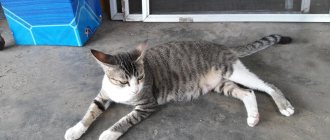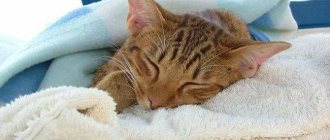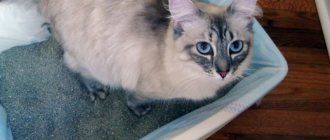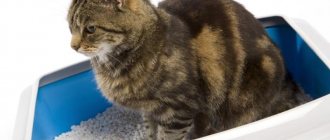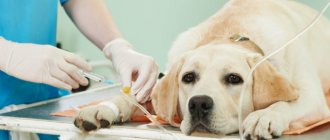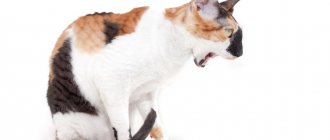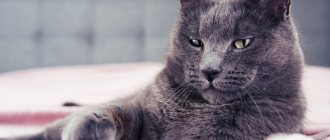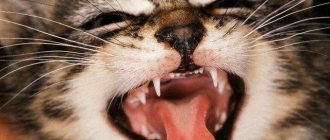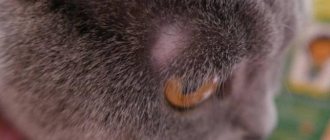The reflex that provokes vomiting is a special mechanism launched by a center in the brain and is carried out by contracting the muscle fibers of the diaphragm and peritoneum. Sudden changes in pressure inside the peritoneum cause a sharp release of stomach contents through the oral or nasal cavity.
If a cat vomits yellow liquid, this may cause problems with the pancreas, stomach, gallbladder or its ducts, as well as problems with the hepatorenal system.
The yellow color of vomit occurs as a result of the penetration of bile. In a normal physiological state, bile should not be in the stomach, since it has a pronounced ability to irritate the walls of the stomach.
In addition to the bright yellow color, the vomit acquires a distinct, specific smell of bile. The appearance of a similar symptom in a cat requires immediate medical attention.
The main causes of vomiting bile
To correctly make a diagnosis, you should pay attention to the factors that provoked vomiting in the cat. It is also important to record the time of the cat’s first vomiting and determine the frequency of vomiting. The main reasons why a cat vomits yellow liquid are presented below.
Vomiting bile in a cat is the first sign of a serious illness
- Presence of a foreign body in the stomach. During play, a pet may swallow a small object, which causes blockage of the esophagus or stomach. If the size of the eaten object is very small, then most often it leaves the body along with the feces. If a larger part is swallowed, the body starts the process of increased secretion and production of bile acid, which are aimed at dissolving various objects in order to speed up the digestion process. Excess bile leaves the body in vomit.
- Change of diet. If the calorie content of a pet's daily diet has increased sharply, then the pet begins to suffer from liver problems. Hepatocytes become unable to quickly adapt to a new regime. This is evidenced by vomit, colored yellow, with the presence of foam, pink mucus and undigested parts of food.
- Parasitic infestation. Severe helminthic infection of the body leads to serious disruption of the digestive system. The cat is vomiting bile and has no appetite. Thus, the body independently tries to get rid of worms.
- Digestive system disorders occur due to rapid absorption of food. Often, such a nuisance can arise from feeding a cat food of poor quality, fatty foods. Bile, produced by the body in large quantities, leaves the body along with the vomit.
- Inflammatory process of the structural components of the liver. Often, when cats vomit yellow foam, veterinarians diagnose hepatitis in cats. In this case, the mucous membrane looks yellowed, the four-legged friend refuses to eat, and the body temperature rises. The urine may darken and problems with bowel movements may occur. In addition to hepatitis, doctors often diagnose liver failure, in which the cat vomits bile and an unpleasant odor emanates from its mouth.
If bile is detected in the vomit, you should immediately seek help from a specialist.
- Lipidosis is a pathology associated with the accumulation of excess fat in the liver area. The functioning of organs is disrupted, and toxic substances begin to accumulate in the body. The animal suddenly loses weight and completely refuses even its favorite food. Due to lipidosis, the cat has yellow vomit. The pet is weakened and spends most of its time hidden in a secluded place. It is important to give the animal something to drink as often as possible, even if the cat runs away. This will help you avoid dehydration.
- The presence of heartworms, along with disturbances in the functioning of the thyroid gland, can cause vomiting of bile in an animal.
- Pathologies of the gallbladder provoke the appearance of yellow vomit in a cat. In this case, the vomit contains a pronounced aroma of bile. In some cases, diarrhea mixed with blood and bile may occur.
- A history of infectious diseases such as herpes, rhinotracheitis, etc. The cat suffers from weakness, yellow vomiting and watery diarrhea. Vomiting can occur both on an empty stomach and after eating. It is necessary to seek help from a doctor as soon as possible.
- Postoperative period. Complications that occur during this period of time can cause yellow vomiting mixed with foam, green/brown mucus and blood. The cat's health is deteriorating. He becomes lethargic and his nose is dry. The fur becomes matted. It is important to immediately take your pet to a veterinarian, who will prescribe the appropriate treatment.
- Pregnancy. During this period, cat pathologies worsen. Vomiting of bile may indicate diseases of the gallbladder and ducts. The cat may vomit all the food it eats.
Note! An animal suffering from vomiting bile needs to be examined by a veterinarian and receive medical attention.
What explains the presence of yellow color
Vomiting bile is a pathology that indicates the accumulation of a large amount of bile in the stomach area. Bile is a powerful reagent that can corrode the gastric mucosa. Often, bile accumulated in the stomach provokes an inflammatory process in the digestive system and the development of ulcers.
Diagnostics
Diagnosis of vomiting with bile may include a whole range of necessary examinations.
Along with a general examination of the animal and taking an anamnesis, the following may be required:
- Blood tests to evaluate liver and pancreas function.
- Ultrasound – to assess the structure of the liver, gallbladder and biliary tract, pancreas, intestines, gastrointestinal motility, and search for tumors.
- X-ray – to exclude foreign objects in the gastrointestinal tract, tumors, gallstones.
- Gastroscopy – examination of the inner surface of the stomach and esophagus using a gastroscope, as well as performing a biopsy for histological analysis of tissue.
What should an owner do if a cat is vomiting?
When your cat vomits yellow liquid, don't panic. One-time vomiting is not dangerous for the animal. If vomiting occurs systematically, it is necessary every 20-30 minutes. pour a large amount of liquid into the oral cavity. When pets vomit, they lose moisture, which causes dehydration. There is no need to feed the cat at this time.
Cat vomits after eating undigested food
It is important to get to the veterinary clinic as soon as possible to show your pet to a specialist. Self-medication in such a situation is unacceptable. Anti-vomiting drugs that are used to treat people should never be given.
Note! If vomiting continues for 5-10 hours, you should immediately call a veterinarian or take the cat to the clinic yourself.
The symptoms described below indicate the need to immediately visit a veterinarian to examine the disease.
- Prolonged vomiting that lasts more than 5 hours.
- The presence of blood clots and bile in the vomit.
- Increased body temperature, accompanied by strong yellow vomit.
- Decreased physical activity, refusal of any food and water, which is accompanied by severe vomiting mixed with bile.
- Systematic vomiting in an animal, regardless of food intake.
Providing first aid to a cat who is vomiting
When vomiting with bile occurs, first of all you need to protect the animal from eating any food until its condition is completely normalized.
Be sure to drink plenty of fluids so that the body does not suffer further from dehydration.
Activated carbon or smecta
From the human first aid kit, smecta can help a cat when vomiting.
If vomiting with bile is caused by an incorrect feeding regimen, regular activated carbon or Smecta will help, as well as about 10-15 ml of a strong mint decoction, which must be forcibly poured into the cat.
If all the methods described above do not give a positive result, you need to take the injured cat for a consultation with a veterinarian as soon as possible.
Preventive measures
Don't neglect vaccination.
If the cat is: healthy, active, does not suffer from chronic diseases, but unpleasant symptoms periodically occur, prevention should be undertaken.
- First of all, you need to establish a feeding schedule: feed strictly according to the clock, and do not teach him to ask for treats from the master’s table. It is important to give small portions, since overeating is the cause of gastrointestinal diseases and vomiting.
- Do not forget about timely vaccination, thanks to which you can avoid many infectious diseases.
- Once every six months, even those cats who do not leave the apartment must be given anthelmintic drugs.
What to look for if your cat is pregnant
How often can you wash a cat - how many times a month and examples of when not
Burping in a pregnant cat should not be a cause for concern. During this period, it is acceptable that she will vomit systematically. If an animal bearing offspring suffers from vomiting mixed with bile, it must be shown to a doctor. Often, such symptoms indicate severe intoxication of the pet’s body.
When your cat is vomiting, you need to give more water.
It is important during the period when your furry friend is bothered by the urge to vomit, to take even more care of his health. You should pour water into your cat's mouth as often as possible. The cat menu needs to be changed. It is best to offer dietary wet food. Food is served in small portions every 4 hours, which will avoid irritation of the inflamed stomach.
If a pregnant cat is vomiting every 30-60 minutes, it is best to limit what she eats. In this case, water is poured into the oral cavity often, but in minimal portions. The situation is especially dangerous when, in addition to vomiting, the cat begins to have diarrhea. In this case, the animal’s body loses a large percentage of moisture.
Important! In addition to drinking water, your cat can be given small portions of chamomile decoction, which has a calming effect on the stomach.
When vomiting bile is not dangerous
If during the molting period you notice that your cat is vomiting, then you need to brush it more often.
There are quite “real life” situations when the appearance of vomiting with bile is normal, and the owners have nothing to worry about:
- For cats, a natural behavioral response is to groom their fur with their tongue. It is not surprising that over time a fair amount of hair . To get rid of it, the body provokes a gag reflex.
- Sometimes a similar reaction occurs in animals after undergoing surgery , in particular after sterilization.
- Feed the cat once a day , and very generously, with dry food. A very common situation is when owners are at work all day and cannot feed the cat more often, but in smaller portions. Special automatic feeders will help save the situation, which would “give out” additional food to the pet 1-2 times between the main feedings in the morning and evening.
Feed your cat more often, but less food
Try to feed your cat more often, but in a balanced manner. There is no need to fill the bowl with a heap. Neutered cats may overeat.
In this case, it is important not to forget the basic rule - the more often the cat receives food, the less amount should be eaten at one time. As a compromise, food specifically designed for single feeding of cats is also suitable.
Their composition is not only balanced in all important components, but also contains a lot of dietary fiber.
Animal treatment
When a cat vomits bile, it is necessary to visit a veterinarian as soon as possible, who, after examination, will identify the cause of the unpleasant condition and prescribe the appropriate treatment. Often cats that vomit yellow suffer from:
- liver cirrhosis;
- hepatitis A;
- hepatosis;
- gallstone disease;
- cholecystitis;
- liver failure.
Is it possible to feed a cat both dry and wet food at the same time: examples of mixing
Depending on the diagnosis made by the veterinarian, treatment will be drawn up aimed at eliminating the cause of the ailment.
For hepatitis of a toxic nature, which can be caused by low-quality food or poisoning by a poisonous plant or medication, veterinarians prescribe:
- glucose infusion;
- injections of thiamine and insulin;
- taking medications like Vikasol, aimed at restoring blood clotting;
- taking medications such as holosas, aimed at maintaining liver function.
To treat infectious type hepatitis, which occurs against the background of viral infections and parasitic infestations, a special diet and immunostimulants are prescribed. In addition, the veterinarian prescribes:
- antispasmodics;
- antibiotics;
- Vitamin preparations are the main condition for the treatment of any pathology.
When diagnosing hepatosis, it is advisable to use drug treatment in combination with a special diet. Animal fats in the cat's menu are kept to a minimum. A diet containing a high percentage of protein helps stabilize the furry patient’s condition.
Note! If, in addition to hepatosis, the veterinarian has discovered diabetes mellitus, therapy is prescribed to the cat that is belching bile, on an individual basis, taking into account the characteristics of the body.
Yellow vomit in a cat can signal the development of gallstone disease. The therapeutic goals in this case are based on the use of thermal procedures that help relieve spasms. In addition, it is advisable to give your pet medications that have a choleretic effect. If there is a large formation of stones that block the bile ducts, it is necessary to urgently carry out surgical intervention. In this case, stones are crushed using ultrasonic waves.
Diagnosis of liver failure requires immediate treatment. Cats that vomit both water and bile need:
- relieving the cause of the pathological condition (antimicrobial and hormonal agents are used for this purpose);
- removing toxins from the body;
- regulation of the process of mineral metabolism;
- monitoring the functioning of the heart;
- special diet.
A cat can vomit yellow foam for many reasons.
If you notice vomiting of bile in your pet, you should immediately go to see a veterinarian. Self-medication can cause irreparable harm to your pet's health. For example, the presence of a foreign body in the digestive tract will not resolve on its own. Lack of timely qualified assistance can lead to the death of the animal.
Taking antiemetic medications purchased from a human pharmacy is often ineffective. After all, for proper treatment, you should undergo a diagnosis that will help identify the true cause of the animal’s serious condition.
There are situations when it is unacceptable to hesitate, because the life of a pet is at stake. The most common ones are described below.
- Ingestion of a chemical such as turpentine, solvent, acid. In this case, it is important to immediately pour 1 tbsp into the cat’s mouth. spoon of enterosgel and call a veterinarian immediately.
- Presence of blood in the vomit. The owner of the animal must immediately give 1 tbsp. a spoonful of Vaseline oil to a sick pet.
- Continuous vomiting for 5-7 hours. It is recommended to administer cerucal intramuscularly (0.1 ml per 1 kg of body weight).
Note! If you help an animal in a timely manner, you can save its life.
What to do for prevention
Cat owners who are faced with a situation such as yellow vomiting ask their veterinarian how they can prevent the recurrence of a complex ailment. Below are the basic preventive measures that every pet owner should know.
- The pet's diet must be balanced. You should buy only high-quality food for cats. It is advisable to use natural products for a kitten.
- There should always be clean drinking water in your cat's bowl.
- Raw meat and fish have no place in the furry diet.
- To store medicines and household chemicals, it is worth choosing places inaccessible to animals.
- It is important to promptly vaccinate pets against infectious pathologies.
- Every 6 months, kittens and cats need to be prevented from worms.
- The cat's fur should be systematically combed with a special comb, which will prevent clogging of the stomach with hairballs.
- Small objects and parts should be removed from the floor away from the cat to avoid swallowing a small object.
Vomiting bile is quite dangerous
If vomiting with bile occurs, it is important to monitor the cat's condition. A one-time urge to vomit should not be scary, but a systematic urge to vomit will be a reason to immediately contact a veterinarian. If, when transporting to a doctor, there are concerns that the cat may vomit, it is advisable to use a plastic carrier.
When to urgently contact a veterinarian
You need to quickly take your cat to the clinic in the following cases:
- impotence (the animal cannot rise);
- vomiting does not go away within 1-2 days;
- urges become frequent (more than 3 times a day);
- the cat cannot drink water on its own;
- black masses with the smell of feces;
- body temperature rises;
- convulsions appeared;
- breathing is impaired;
- repeated vomiting of blood or bile;
- rapid deterioration of the cat's condition.
